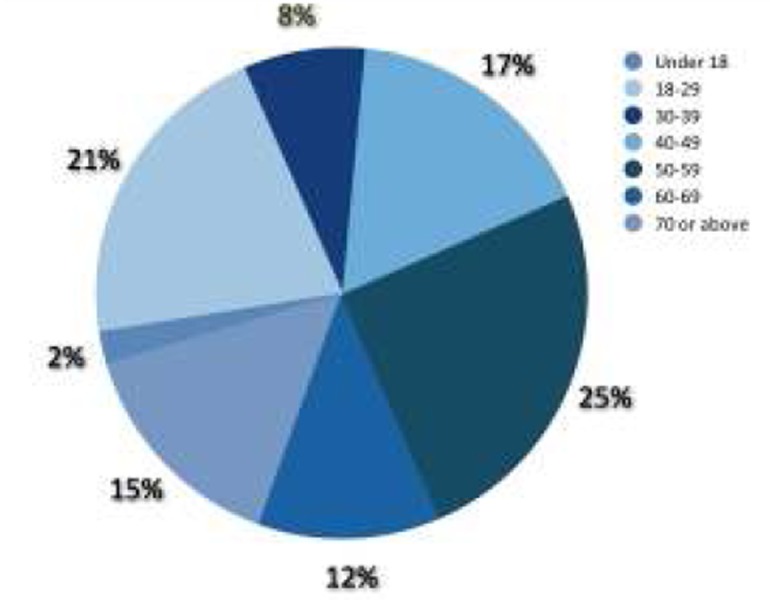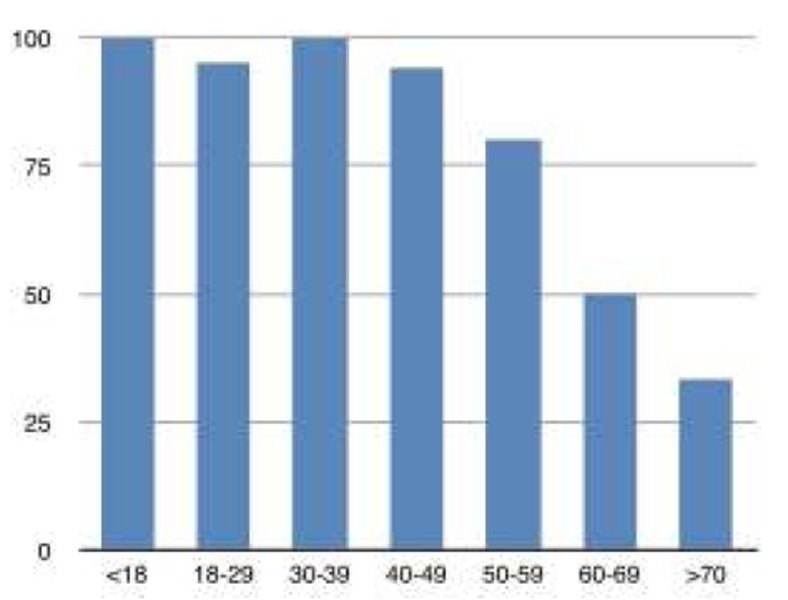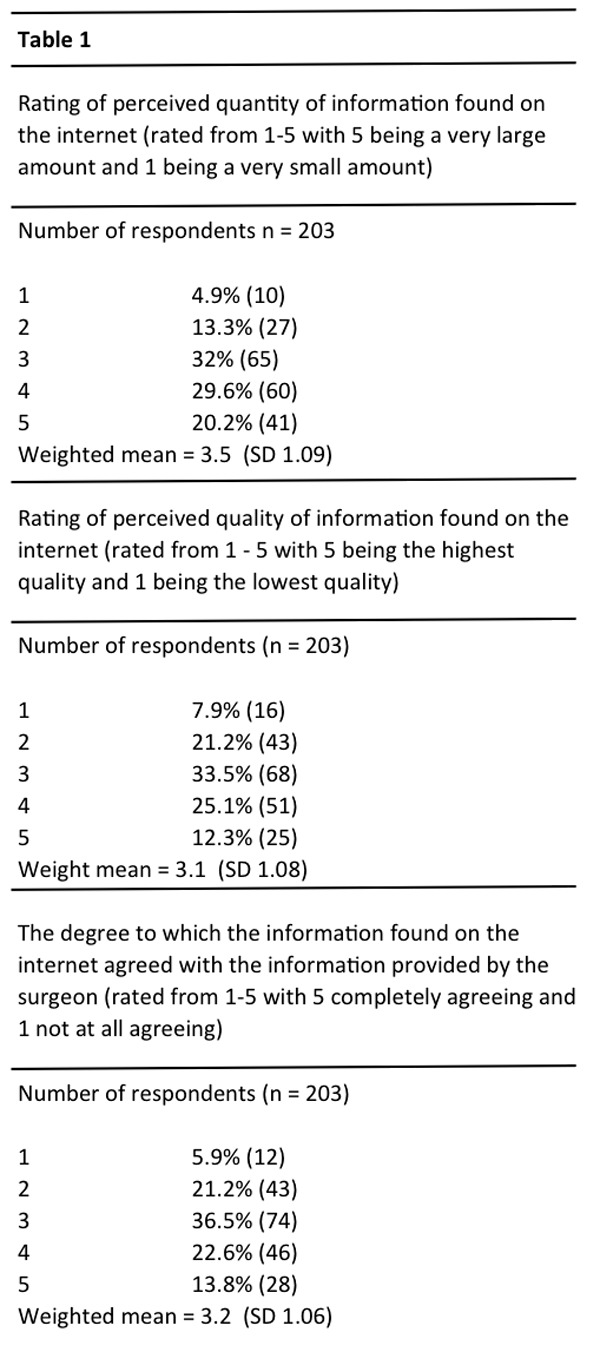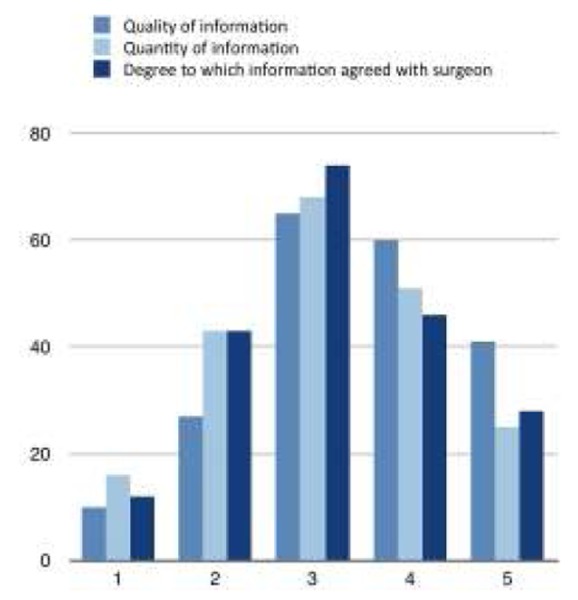Abstract
Background
The e-patient revolution increasingly enables patients to self diagnose and self educate, influencing decisions affecting their health. This poses a challenge for both patients and health care professionals due to the highly variable and often poor quality information available on the internet.
Aims
This study aims to measure the current internet usage in patients attending outpatient clinics, in both a public and private setting. All patients were recruited whilst consulting orthopaedic surgeons.
Method
We developed a 29 question survey which asked questions related to patient demographics, general internet usage and internet usage related to the patient’s orthopaedic condition. Patients were recruited for the public cohort during Western Health outpatient clinics and for the private cohort during private surgical consults in the waiting rooms of eight surgeons’ clinics.
Results
A total of 400 surveys were completed; 200 in both the private and public cohorts of the study. Of all surveyed participants, 79% (n = 316) had access to the internet. Of people who had access to the internet 65.2% (n = 206) used the internet to investigate their orthopaedic condition. 29.6% (n = 61) of participants asked their surgeon questions related to information they had read on the internet. Of patients that had access to the internet 36.1% (n = 114) used the internet to research their surgeon.
Conclusion
Patients are commonly using the internet as an information resource, in spite of the highly variable quality of this information. This highlights the need for patient information websites which reflect the current standards of clinical practice.
Keywords: Online medical information, Internet use, Patient’s awareness, orthopaedics
What this study adds:
Medical information aimed at patients found on the internet is highly variable and often of poor quality.
This study quantifies the frequency of internet use in an outpatient population with musculoskeletal conditions under the care of orthopaedic surgeons.
This study highlights the need for a source of quality information for patients in an online format, ideally recommended by their consulting medical practitioner. It also highlights the need for private surgeons to provide an online presence which accurately reflects their scope of practice.
Background
Internet usage within the broader community has followed sustained high-level growth since its popularisation in the early nineties. Recent figures indicate that the number of Australians with internet access has grown from 3.2% of the population in 1996 to 74% in 2009.1 Greater accessibility to the internet has provided a novel method for patients to access health information and play a greater role in decisions ultimately affecting their health.2 Increasingly patients are turning to the internet to gain more information and understanding about their condition.2 This poses a challenge for both patients and health care professionals due to the highly variable and often poor quality information, available on the internet.3-4 The importance of internet resources is emphasised by studies which have shown that their content may influence a patient’s decision about their related medical treatment.5
We have performed a cross-sectional descriptive study which aims to quantify internet usage by orthopaedic outpatients in both private orthopaedic clinics as well as public hospital outpatient clinics, bringing an up-to-date perspective to studies previously carried out in this area.6-12 We used surveys which targeted three main domains: 1) patient demographics; 2) general internet usage; 3) internet usage directed towards the patient’s current orthopaedic condition. In this last domain we surveyed patients’ perceptions of the quantity and quality of information they found related to their condition, the degree to which the information they found on the internet correlated with the information provided to them by their surgeon, and to what degree internet-based resources shaped the questions they asked of their surgeon.
The aim of the study is to describe how patients are using the internet with respect to their orthopaedic condition in the current climate of widespread internet access. We seek to investigate whether this practice is widespread and to what degree it influences patients’ understanding of their condition as well as their perception of their doctors. It may inform the need for closer guidance from medical practitioners in how patients use the internet.
Method
Survey instrument
We developed a 29 question survey which asked questions related to patient demographics, general internet access/usage and internet usage related to the patient’s orthopaedic condition. No validated survey could be found to meet the requirements of this investigation. The survey was constructed using the Lime Survey application. The formulation of this survey was a collaborative process between the authors of this article with questions aimed at exploring the three areas of interest.
The survey covered demographic information including age, gender, country of origin, language preferences, educational background, orthopaedic condition, and the stage of consultation (pre-operative/post-operative). General internet usage was surveyed, including access to internet, frequency and expertise of internet usage.
Internet usage relating to the patient’s orthopaedic condition was surveyed with areas such as, the stage of clinical management when the search was carried out (pre or post-operatively), the patient’s rating of quantity and quality of information found related to their condition, and the method used to find the best website they accessed. The survey also quantified the degree to which information found online correlated with that provided by the surgeon and whether internet-based information led to the patient asking questions of their surgeon. The survey also asked if the patient had searched the internet for information regarding their surgeon and, if so, at what point in the treatment course (pre or post-operatively) they did so.
Once completed, this survey was submitted as part of our ethics approval application, which was attained from The Western Health Ethics Panel in accordance with the requirements of the National Health and Medical Research Council of Australia (NHMRC).
Recruitment
This study was carried out from March 2012 until May 2012. Patients were recruited for the public cohort during Western Health Orthopaedic outpatient clinics. All patients attending these clinics were invited to participate in the study. Informed consent was obtained and patients were provided with survey forms in English, with assistance being provided by attending medical students. The surveys were completed on site and collected prior to discharge from the clinic. Patients were asked if they had completed the survey previously and excluded if this had occurred.
Patients were recruited for the private cohort during private surgical outpatient consults in the waiting rooms of eight surgeons’ clinics. The age of participating surgeons ranged from 45–59 years. The practices of the eight surgeons were located across a broad geographical distribution in Melbourne. Each surgeon completed a minimum of 20 surveys and a maximum of 30 surveys. All patients attending these clinics were invited to participate in the study, and once informed consent was obtained, patients were provided with survey forms with assistance being provided by attending medical receptionists. The surveys were completed on site and collected prior to departure from the clinic. All surveys were completed anonymously.
Data analysis
Statistical analysis of the data was carried out using STATA software. All data collected was tabulated using Lime Survey software. All results were presented as proportions or means. The chi2 test was used to compare proportions. A two sided T-test was used to compare means. P values of <0.05 were considered significant for both statistical measures.
Results
A total of 400 surveys were completed; 200 in both the private and public cohorts of the study. Approximately 70% of the total patients approached consented to partake in the survey. Of those surveyed, the age of participants ranged from under 18 years of age to 70 or above (Figure 1). The average age of participants was 40-49 in both the public and private cohort. Of those surveyed, 4.5% (n=18) were educated to a primary school level, 35% (n=170) secondary level, 27.5% (n=110) trade or TAFE certificate, 21.3% (n=85) tertiary level and 4.3% (n=17) had a graduate qualification (masters or PhD).
Figure 1. Age range of cohort.

Of all surveyed participants, 79% (n = 316) had access to the internet. Access to the internet had a declining relationship to age with the highest proportions seen in the <18 age range and lowest proportions seen in the >70 age range (Figure 2). There was an observable increase (p<0.01) in the proportion of patients using the internet in the private cohort (89.5% / n = 179) as compared to the public cohort (73.5% / n = 147). Education level also had a significant impact on internet access with 27.8% (n = 5) of people with a primary school education or no formal education, 66.5% (n=113) of people with high school education, 86.3% (n=95) with a trade or tafe certificate and 100% (n = 102) of people with some university, a university degree or a graduate degree having access to the internet. Of people that had access to the internet, 13.3% (n = 42) rated themselves as an expert user, 40.8% (n = 129) rated themselves experienced, 29.4% (n = 93) intermediate, 11.4% (36) beginner and 5.1% (n = 16) novice.
Figure 2. Internet usage by age range.

Of people who had access to the internet, 58.2% (n = 184) used the internet to investigate their orthopaedic condition. A further 7% (n = 22) had someone they knew use the internet to investigate their condition on their behalf. This amounted to a total of 65.2% of people with internet access investigating their condition via the internet, and represented 51.5% of all patients surveyed, a total of 206 people. Of those who did research their condition on the internet, 49.2% did so prior to their appointment with the surgeon, 42% following their appointment, and 27.5% both prior to and following their appointment. People who rated themselves as being more experienced with the internet were also more likely to research their Orthopaedic condition on the internet. People whom had a higher level of education were also more likely to research their condition on the internet. This becomes clear when we look at the percentage of each education level that researched their condition using the internet. This amounted to 5.5% (n = 1) of those primary school educated, 47.1% (n = 80) of those secondary school educated, 44.5% (n = 49) of those with a trade or TAFE certificate, 72.9% (n = 62) of those tertiary educated and 82.4% (n = 14) of those with a graduate qualification.
When broken into private and public cohorts, there was an observable difference in the proportion of patients using the internet to research their condition; 41.5% of patients in the public cohort as compared to 55% of patients in the private cohort used the internet to research their condition. This difference however was not statistically significant (p>0.05) when considered as a proportion of only the patients who had access to the internet. In this instance 55.8% (n = 82) of patients in the public cohort used the internet to research their condition as compared to 62.6% (n = 112) of the private cohort. The discrepancy lies in the fact that a higher percentage of private patients had access to the internet as compared to public patients.
With respect to the information found while using the internet, we asked patients to rate the quantity and quality of the information they found as well as the degree to which the information agreed with that supplied by the surgeon during their consult. For results of this data see Table 1 and Figure 3. There were 203 people that contributed to this data rather than the expected 206 due to three people not filling out this section even though they had used the internet to research their condition.

Figure 3. Patient ratings of quality, quantityand level of agreement with surgeon for information found using the internet.

The weighted average for the ratings of the quantity of information was 3.5/5, quality of information 3.1/5 and degree to which this information correlated with the surgeon 3.2/5.
When asked how patients found the best website they accessed whilst investigating their condition on the internet, the overwhelming majority used a search engine (78.2% / n = 161). Other sources included the surgeon’s advice (14.1% / n = 29), a doctor’s advice (4.9% / n = 10) and word-ofmouth (3.4% / n = 7). When considering only those people that had been recommended a website by their surgeon or doctor, the weighted average for the quantity of information was 3.5/5, the quality of information was 4.3/5 and the degree to which this information agreed with the surgeon was 4.5/5. This is seen as a significant increase in patient rating for quality of information (P<0.01) and the degree to which the information agreed with the surgeon (P < 0.01).
We found that 29.6% (n = 61) of participants who used the internet to research their condition asked their surgeon questions related to information they had read on the internet.
Of patients that had access to the internet 36.1% (n = 114) used the internet to research their surgeon. When considering private and public cohorts independently, of public patients which had access to the internet, 11.6% (n = 17) used the internet to research their surgeon as compared to 54.2% (n = 97) of private patients.
Discussion
The internet continues to provide an ever-expanding horizon of possibilities for enhancing patient care through provision of information. With this rapid expansion, however comes the risk of patients accessing information that may be misleading or inaccurate. Multiple studies have been published analysing the quality of information related to medical conditions, including those of an orthopaedic nature.3-4,14-16 These studies have all shown that the information that is easily accessed through common search terms using internet search engines is often of poor quality, highly variable, commercially driven, and often not in keeping with current practices of diagnosis and treatment.
This study found that over half the patients attending orthopaedic surgeons had used the internet to research their condition. This figure was even higher when considered as a proportion of only the patients who had access to the internet. Patients reported that there was a large quantity of information found on the internet relating to their condition. Patients’ rating of the quality of information was skewed towards patients rating the information more highly than the literature might suggest is the case.
This study found that the overwhelming majority of patients who researched their condition on the internet used search engines to find the websites they visited. Only a very small proportion of patients were given recommendations of a website by their surgeon or doctor. We found that when patients were recommended a website by their doctor or surgeon, they consistently rated the quality of information and degree to which this information agreed with the surgeon higher than those not recommended by a medical practitioner.
Given this finding, it would be advisable for doctors and surgeons to guide their patients by recommending websites which provide information that is in keeping with current methods of diagnosis and treatment. This could be done as a matter of course at the end of each consultation and would ensure a consistency of information relating to their condition. It would be ideal for physicians to view patient internet searches as an opportunity for communication and enhancement of patient education, rather than something to be avoided.
We found that almost one-third of patients who used the internet to research their condition, asked questions related to information they had found on the internet. This is an important point given that previous studies have shown that information found on the internet can influence patients’ decision-making with respect to management options for their condition.5 With this in mind it is important that these questions not be dismissed and further questioning by the practitioner regarding the source of information would be appropriate.
An interesting finding of this study was that over half the patients in the private cohort with internet access had used the internet to research their surgeon. This brings into focus the need for private surgeons to provide an internet presence that accurately represents the practices of that particular surgeon. For many surgeons, the consultation may start well before they have met the patient through online contact, in an entirely anonymous manner, and may ultimately play a role in whether the patient decides to consult a particular surgeon. As such, a practice website providing information about the surgeon is recommended given the frequency with which patients are using the internet to research their surgeons. Furthermore it would be worthwhile to provide information on conditions commonly treated by the surgeon, ensuring that the quality of information their prospective patients are accessing is in keeping with current trends in diagnosis and treatment. Fewer patients performed this search in the public cohort presumably due to public patients having less interaction with the surgeon responsible for their care as compared to the private cohort.
Conclusion
In summary, we found that patients are commonly using the internet as an information resource with regards to their condition in spite of the highly variable quality of this information. This brings into focus the need for patient information websites which reflect the current standards of clinical practice and recommendations from doctors and surgeons in order that patients can source information which is accurate. Future research in this area could investigate the potential harms or benefits to patients in relation to their internet searches, how the behaviour of patients with respect to doctors is affected by information found on the internet and investigation into the best method of educating patients about how to search the internet for accurate information.
ACKNOWLEDGEMENTS
Text
Footnotes
PEER REVIEW
Not commissioned. Externally peer reviewed.
CONFLICTS OF INTEREST
The authors declare that they have no competing interests.
FUNDING
None
ETHICS COMMITTEE APPROVAL
Western Health Low Risk Human Research Ethics Panel. QA Number: 2012.06
Please cite this paper as: Fraval, A. Chong, YM. Holcdorf, D. Plunkett, V. Tran, P. Internet use by orthopaedic outpatients - current trends and practices. AMJ 2012, 5, 12, 633-638.http//dx.doi.org/10.4066/AMJ.2012.1530.
References
- 1.Australian Bureau of Statistics. Australian Social Trends [Internet]. 2011 Jun; 2011, cat. no. 4102.0, ABS, Canberra. Available from: www.abs.gov.au/socialtrends. [Google Scholar]
- 2.Ilic D. The role of the internet on patient knowledge management, education, and decision-making. Telemed J E Health. 2010 Jul-Aug;16(6):664–9. doi: 10.1089/tmj.2010.0003. [DOI] [PubMed] [Google Scholar]
- 3.Silberg WM, Lundberg GD, Musacchio RA. Assessing, controlling, and assuring the quality of medical information on the internet: caveant lector et viewor – let the reader and viewer beware. JAMA. 1997 Apr 16;277(15):1244–5. [PubMed] [Google Scholar]
- 4.Saithna A, Ajayi OO, Davis ET. The quality of internet sites providing information relating to hip resurfacing. Surgeon. 2008 Apr;6(2):85–7. doi: 10.1016/s1479-666x(08)80070-4. [DOI] [PubMed] [Google Scholar]
- 5.Groves ND, Humphreys HW, Williams AJ, Jones A. Effect of informational internet web pages on patients’ decision-making: randomised controlled trial regarding choice of spinal or general anaesthesia for orthopaedic surgery. Anaesthesia. 2010 Mar;65(3):277–82. doi: 10.1111/j.1365-2044.2009.06211.x. [DOI] [PubMed] [Google Scholar]
- 6.Beall MS 3rd, Beall MS Jr, Greenfield ML, Biermann JS. Patient Internet use in a community outpatient orthopaedic practice. Iowa Orthop J. 2002;22:103–7. [PMC free article] [PubMed] [Google Scholar]
- 7.Beall MS 3rd, Golladay GJ, Greenfield ML, Hensinger RN, Biermann JS. Use of the Internet by pediatric orthopaedic outpatients. J Pediatr Orthop. 2002 Mar-Apr;22(2):261–4. [PubMed] [Google Scholar]
- 8.Gupte CM, Hassan AN, McDermott ID, Thomas RD. The Internet—friend or foe? A questionnaire study of orthopaedic out-patients. Ann R Coll Surg Engl. 2002 May;84(3):187–92. [PMC free article] [PubMed] [Google Scholar]
- 9.J. Jariwala AC, Kandasamy, Abboud RJ, Wigderowitz CA. Patients and the Internet: a demographic study of a cohort of orthopaedic out-patients. Surgeon. 2004 Apr;2(2):103–6. doi: 10.1016/s1479-666x(04)80053-2. [DOI] [PubMed] [Google Scholar]
- 10.Krempec J, Hall J, Biermann JS. Internet use by patients in orthopaedic surgery. Iowa Orthop J. 2003;23:80–2. [PMC free article] [PubMed] [Google Scholar]
- 11.Wright JE, Brown RR, Chadwick C, Karadaglis D. The use of the Internet by orthopaedic outpatients. J Bone Joint Surg Br. 2001 Nov;838:1096–7. doi: 10.1302/0301-620x.83b8.12390. [DOI] [PubMed] [Google Scholar]
- 12.Baker JF, Devitt BM, Kiely PD, Green J, Mulhall KJ, Synnott KA, Poynton AR. Prevalence of Internet use amongst an elective spinal surgery outpatient population. Eur Spine J. 2010 Oct;19(10):1776–9. doi: 10.1007/s00586-010-1377-y. Epub 2010 Apr 2. [DOI] [PMC free article] [PubMed] [Google Scholar]
- 13.Beredjiklian PK, Bozentka DJ, Steinberg DR, Bernstein J. Evaluating the source and content of orthopaedic information on the Internet. The case of carpal tunnel syndrome. J Bone Joint Surg Am. 2000 Nov;82-A(11):1540–3. doi: 10.2106/00004623-200011000-00004. [DOI] [PubMed] [Google Scholar]
- 14.Starman JS, Gettys FK, Capo JA, Fleischli JE, Norton HJ, Karunakar MA. Quality and content of Internet-based information for ten common orthopaedic sports medicine diagnoses. J Bone Joint Surg Am. 2010 Jul 7;92(7):1612–8. doi: 10.2106/JBJS.I.00821. [DOI] [PubMed] [Google Scholar]
- 15.Sambandam SN, Ramasamy V, Priyanka P, Ilango B. Quality analysis of patient information about knee arthroscopy on the World Wide Web. Arthroscopy. 2007 May;23(5):509–513. doi: 10.1016/j.arthro.2006.12.007. [DOI] [PubMed] [Google Scholar]
- 16.Smith JT, Pate OL, Guss D, Lee JT, Chiodo CP, Bluman EM. Internet information quality for ten common foot and ankle diagnoses. Foot Ankle Surg. 2012 Sep;18(3):198–202. doi: 10.1016/j.fas.2011.11.002. Epub 2011 Dec 5. [DOI] [PubMed] [Google Scholar]


